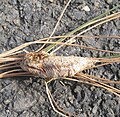
The Carolina mantis is a species of praying mantis of the subfamily Stagmomantinae.

Dictyoptera is an insect superorder that includes two extant orders of polyneopterous insects: the order Blattodea and the order Mantodea (mantises). All modern Dictyoptera have short ovipositors and typically lay oothecae. The oldest fossils of Dictyoptera from the Late Carboniferous, referred to as "roachoids" have long ovipositors and did not lay oothecae. The oldest modern oothecae-laying dictyopterans date to the Late Triassic.

The Chinese mantis is a species of mantis native to Asia and the nearby islands. In 1896, this species was accidentally introduced by a nursery tender at Mt. Airy near Philadelphia, United States. Tenodera sinensis often is erroneously referred to as Tenodera aridifolia sinensis because it was at first described as a subspecies of Tenodera aridifolia, but Tenodera sinensis is now established as a full species.

Tenodera is a genus of mantis in the family Mantidae which contains several species of praying mantises. The species in this genus can be found primarily in Africa, Asia and Australia, but also North America.

Miomantis caffra is a species of praying mantis native to southern Africa. It appeared in New Zealand in 1978, and was found more recently in Portugal and Los Angeles, USA, likely spread through the exotic pet trade. Females are facultatively parthenogenetic and unmated females can produce viable offspring.
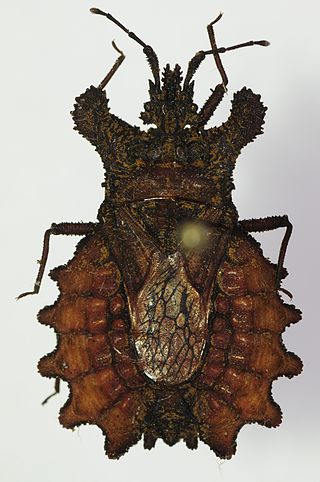
Aradidae is a family of true bugs (Heteroptera). Family members are commonly known as flat bugs due to their dorsoventrally flattened bodies. With few exceptions, these cryptic insects are of no economic importance.

Iris oratoria, known by the common name Mediterranean mantis, due to humans first studying it in lands around the Mediterranean Sea, is a species of praying mantis. Its range is expanding in the Middle East, Western Asia and the United States.

Aptery is the anatomical condition of an animal completely lacking any kind of wings. An animal with this condition is said to be apterous.

Phyllocrania paradoxa, common name ghost mantis, is a small species of mantis from Africa remarkable for its leaf-like body. It is one of the three species in the genus Phyllocrania. It is known for its distinct and exclusive camouflaged appearance of a dry weathered leaf.
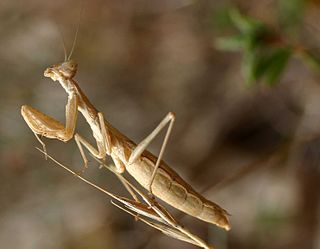
Ameles decolor is a species of small praying mantis native to the west Mediterranean and North Africa. A. decolor was first described by entomologist Domenico Cyrillo in 1787, and its current classification was established in 1976 by Karl Harz and Alfred Peter Kaltenbach. A. decolor presents as a small, light brown mantis with females tending to appear larger than their male counterparts. The mating patterns of A. decolor are considered some of the most complex amongst praying mantises, with males presenting two different styles of courtship. Their habitat favours shrublands, grasslands, and wooded areas.
Pseudovates peruviana, common name Peruvian stick mantis, is a medium-sized species of praying mantis endemic to Peru.

Megathymus yuccae, the yucca giant-skipper, is a rare early season butterfly that is widespread across the southern United States. It belongs in the family Hesperiidae, subfamily Megathyminae.
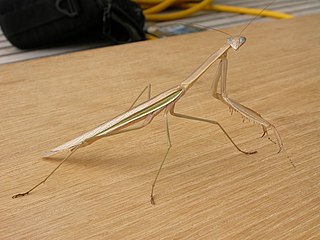
Tenodera australasiae, the purple-winged mantis, is species of praying mantis. Found throughout Australia, it is common in the eastern regions. Both males and females are capable of flight. The species has not been shown to be parthenogenetic.
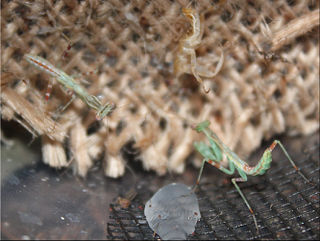
Miomantis binotata, the African pinstripe mantis, is a small species of praying mantis found in Africa that are bred in captivity in the pet trade.

An avivore is a specialized predator of birds, with birds making up a large proportion of its diet. Such bird-eating animals come from a range of groups.
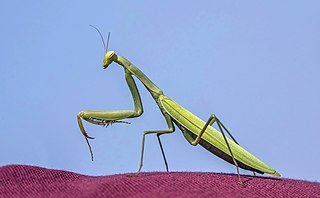
Mantises are an order (Mantodea) of insects that contains over 2,400 species in about 460 genera in 33 families. The largest family is the Mantidae ("mantids"). Mantises are distributed worldwide in temperate and tropical habitats. They have triangular heads with bulging eyes supported on flexible necks. Their elongated bodies may or may not have wings, but all Mantodea have forelegs that are greatly enlarged and adapted for catching and gripping prey; their upright posture, while remaining stationary with forearms folded, has led to the common name praying mantis.

Tenodera aridifolia, the Japanese giant mantis, is a species of mantis in the subfamily Mantinae. The Chinese mantis, T. sinensis, was once considered to be a subspecies of T. aridifolia, but the species can be distinguished by the shape of male genitalia.

Rhyothemis fuliginosa, also known as the butterfly dragonfly or the butterfly flutterer, is a species of dragonfly of the family Libellulidae found throughout East Asia, in the countries of Japan, China, Taiwan, and the Korean Peninsula.
Podagrion mantis was first described in 1886 by W.H. Ashmead and was the first species of its genus to have been described from the United States. All species in the genus are parasitoid wasps known only to parasitize mantids. They have been observed most often utilizing the egg case (ootheca) of Stagmomantis carolina, but have also been reported to choose S.limbata or Tenodera angustipennis as hosts, showing a high degree of specialization.



